The Lab Shiba mix, also known as the Shibador, is a designer dog that results from crossing a Labrador Retriever and a Shiba Inu. This crossbreed is known for its charming personality, intelligence, and loyalty, making it a popular choice for families and individuals looking for an affectionate and loyal companion.
The Labrador Retriever is known for its friendly and outgoing nature, while the Shiba Inu is known for its independent and confident personality. Combining these two breeds results in a loyal, affectionate, intelligent, and independent dog.
In this article, we will explore the characteristics and traits of the Lab Shiba mix and provide insights into what makes them such great pets.
A Brief Overview of Lab Shiba Mix
| Other Names | Shiba Inu Lab Retriever Mix, Shiba Lab, Shiba Labrador, Shibador |
| Purity | Hybrid |
| Purpose | Companion dog |
| AKC Recognition | No |
| Size | Medium |
| Weight Range | 30 – 50 pounds |
| Height Range | 13 – 23 inches |
| Coat Colors | Short to medium-length, dense, and weather-resistant |
| Temperament | Friendly, loyal, and intelligent |
| Compatibility | Can be good with children and other pets if properly socialized and trained |
| Training Difficulty | Responds well to positive reinforcement training methods |
| Health Issue | May be prone to certain genetic health conditions, regular vet check-ups recommended |
| Lifespan Range | 12 – 16 years |
| Living Environment | Can adapt to various living situations, but regular exercise is important for their well-being |
What is a Lab Shiba Mix?
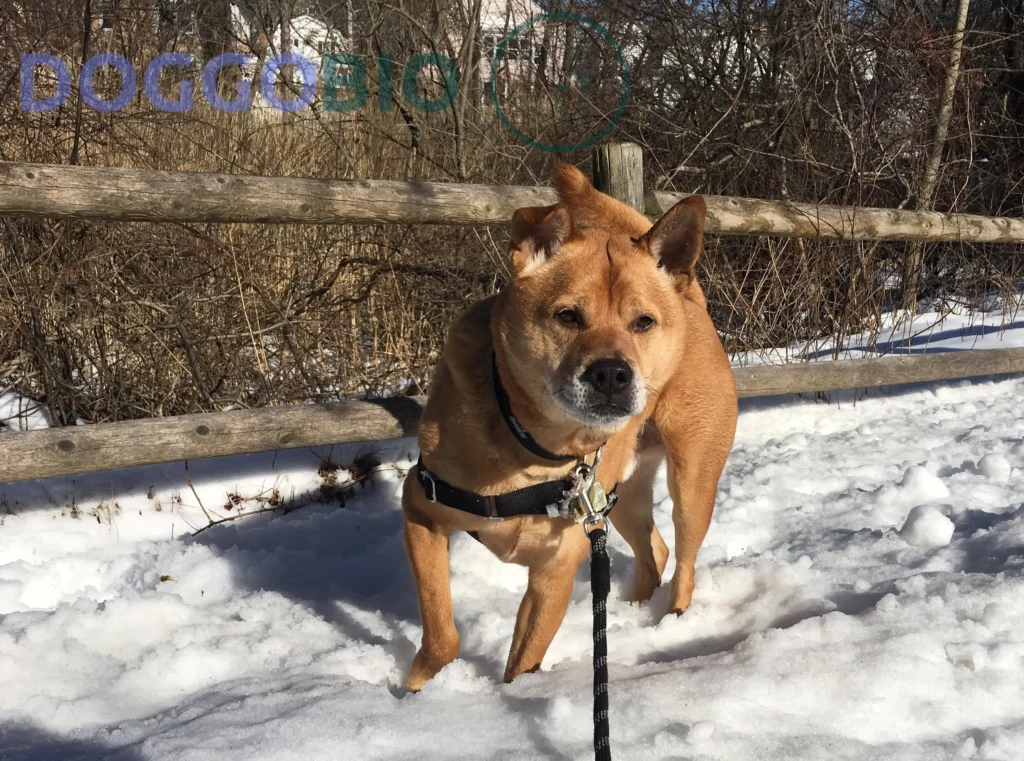
A Shiba Inu Labrador Mix is the offspring of two distinct breeds: the feisty Shiba Inu and the gentle Labrador Retriever.
These furry wonders are frequently known as Shibalabs or Shibadors and are the ultimate hybrid of two vastly different personalities.
Parent Breeds of Lab Shiba Mix
The Lab Shiba Mix, a designer breed, could inherit the prominent traits of one parent or a blend of both. Knowing each parent breed’s distinctive features could help determine this mix’s possible outcome.
Origins and History of Shiba Inu
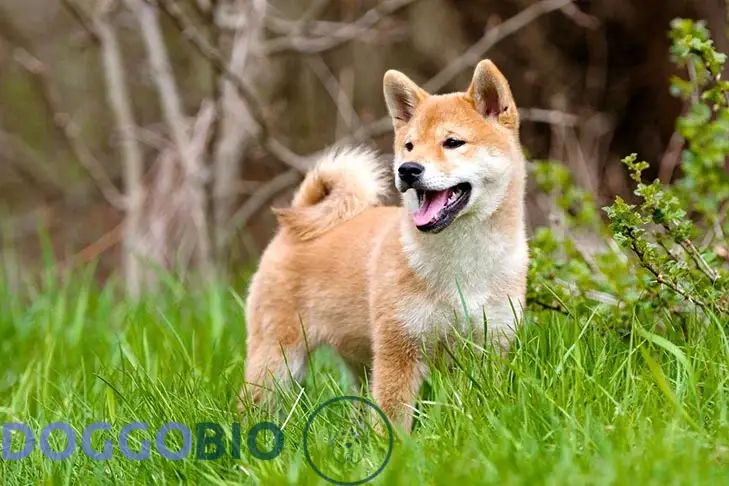
Shiba Inu has an extensive history dating back thousands of years. They came from the mountainous Chubu region in Japan, where they were utilized for hunting birds and rabbits.
However, during the early 1900s, purebred Shiba Inus suffered a significant blow, losing almost all their numbers due to wars, illness, and limited food supply.
Fortunately, the remaining purebreds were crossed with other Japanese dog breeds like the San’in, Mino, and Shinshu, creating the contemporary Shiba Inu we have today.
Origins and History of Labrador Retrievers
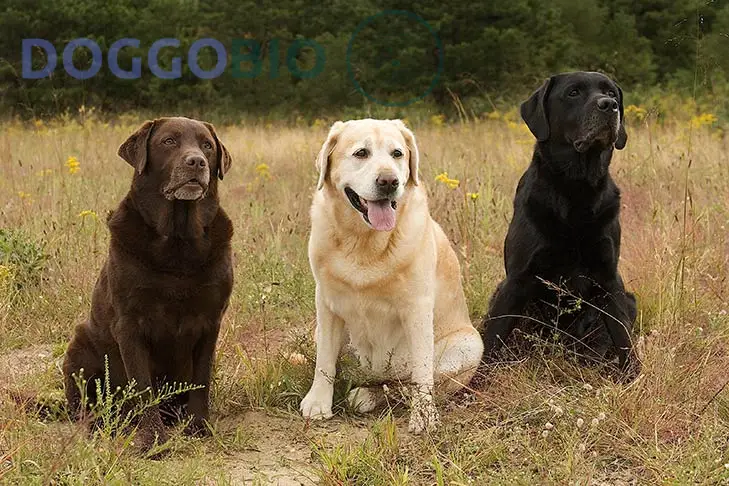
The origin story of the Labrador Retriever is one of adventure and exploration. These pups came from Newfoundland and Labrador’s cold and rugged terrain, where they were bred as working dogs for fishermen to help retrieve their nets and haul in their catch.
In the early 1800s, the breed traveled across the ocean to England, capturing the hearts of hunters and athletes alike. They were bred with local hunting dogs, creating a unique breed well-suited to the British countryside.
The first Labrador Retriever was a bold and beautiful black, but other hues like yellow and liver soon entered the scene. With their friendly and playful personalities, it’s no wonder that the Labrador Retriever quickly became one of the most beloved dog breeds in the world.
What Does a Lab Shiba Mix Look Like?
A Lab Shiba Mix typically has a sturdy and robust build, and the fox-like traits of the Shiba Inu are rarely retained. However, they usually inherit the distinctive triangular eyes characteristic of the Japanese breed.
The ears of a Shiba Inu mixed with Lab can either be floppy or slightly erect, depending on which parent’s genes are more dominant. The muzzle is medium-sized and slightly tapered, which gives them a unique and charming appearance that sets them apart from other dog breeds.
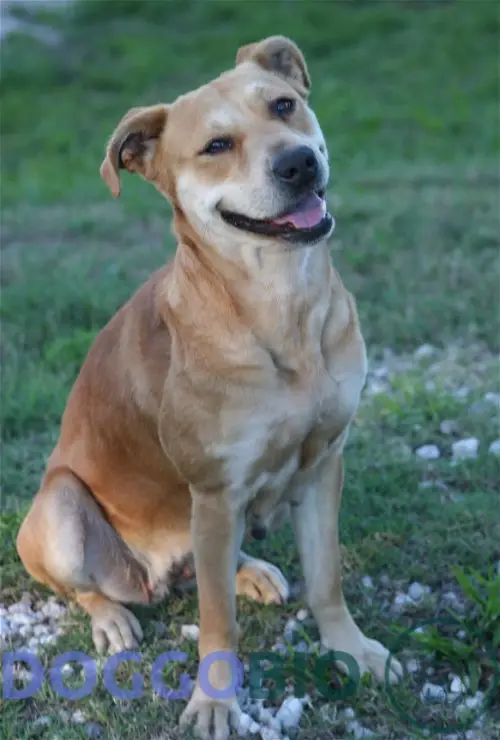
Size, height, and weight
The Shiba Inu Lab Mix is a medium-sized dog with a unique blend of characteristics. They are shorter than Labradors but slightly longer than Shiba Inus. By their first year, they reach their full height, with males being slightly taller than females.
Their weight can vary widely depending on their genetic mix, usually ranging from 30 to 50 pounds once they are fully grown. Diet, exercise, and overall health play significant roles in their weight, given their athletic build.
It’s crucial to monitor their weight to ensure they stay within a healthy range. Overfeeding and lack of exercise can lead to obesity and health issues, so it’s essential to establish a balanced routine and diet for your Lab Shiba Mix.
| Age | Male | Female |
| 3 months | 7 – 10 inches / 8 – 20 pounds | 7 – 10 inches / 8 – 20 pounds |
| 6 months | 10 – 15 inches / 20 – 30 pounds | 10 – 12 inches / 20 – 25 pounds |
| 9 months | 15 – 18 inches / 30 – 40 pounds | 13 – 16 inches / 25 – 35 pounds |
| 12 months | 19 – 23 inches / 40 – 50 pounds | 16 – 20 inches / 35 – 45 pounds |
Coat colors and types
The Lab and the Shiba Inu have short and dense double coats, but the Lab’s coat lies flat on their body, while the Shiba Inu’s skin has a different texture. The Shiba Inu mixed with Lab can have an outer coat that’s either stiff and straight or flat and slightly wavy, depending on the parentage.
Labradors have a limited color range of black, chocolate, and yellow, while the Shiba Inu has four primary color variations: red, black and tan, sesame, and cream. Therefore, the Shiba Inu mixed with Lab will have a coat that combines these hues, and some may have white markings on the face, cheeks, neck, and chest for extra pizzazz!
Temperament and Personality
The Shiba Inu Lab Mix has a unique personality that blends its two parent breeds. While the Shiba Inu can be reserved and independent, the Labrador is known for its outgoing and friendly nature.
As a result, the Lab Shiba Mix is a friendly and playful breed that enjoys spending time with its family but also values some alone time occasionally.
Regarding temperament, the Shiba Inu Lab Mix inherits a strong prey drive from both parents due to their hunting and retrieving backgrounds. However, with proper training, this instinct can be redirected. Their intelligence and alertness make them quick learners and highly motivated to perform tasks.
Is Lab Shiba Mix a good fit for families?
Yes, Shiba Inu mixed with Labrador makes a great family pet. This breed has a generous and genial temperament, making them an ideal companion for children and other pets.
However, kids can get agitated if bothered excessively, especially by kids. Hence, it is wise to supervise their interaction with children to prevent any unwanted incidents.
Do Shiba Lab Mixes affectionate dogs?
Yes, Shiba Lab Mixes are affectionate dogs.
Shiba Inus are independent and show affection subtly, often by staying close but not too clingy. Labradors, on the other hand, are overtly affectionate and love to snuggle. A Shiba Lab Mix will likely blend these traits, being loving and loyal without being overly demanding. They’re great for families wanting a moderately affectionate pet.
Training
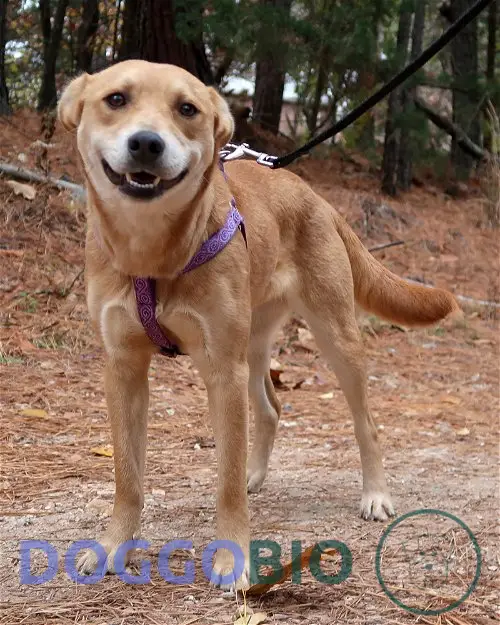
Lab Shiba Mix training can be perplexing. While the Labrador is easily motivated to learn new tricks, the Shiba Inu is more independent, stubborn, and challenging.
But training your Lab Shiba Mix at an early age can help you overcome this hurdle. Regular obedience training and socialization with other dogs and humans can also help improve their temperament.
It’s worth noting that first-time dog owners may find it more challenging to train a Lab Shiba Mix, so it’s essential to have a lot of patience and perseverance.
Exercise Requirements
It’s time to get up and get moving because the Shiba Inu Labrador mix loves to play! Their lively nature makes them always ready for action and enjoy nothing more than being active.
Taking them for a walk around the block or heading to the park to play a game of fetch is the perfect way to get their hearts pumping and their bodies moving. In fact, with their high energy levels, Shiba Inu Labrador mixes require at least an hour of exercise each day.
Regular exercise is essential to keep their muscles and bones in top shape and reduce the likelihood of health problems such as obesity. So, whether galloping around the yard or playing an intense soccer game, Shibadors need to move their bodies and get their exercise fixed.
Living Conditions
Lab and Shiba Inu Mixes are versatile and can thrive in any living environment, whether a spacious house or a cozy apartment. But, it is essential to provide them with ample exercise opportunities to prevent them from getting bored and anxious.
Grooming and Cleaning
In general, they have a moderate grooming requirement. Regular brushing is necessary to maintain their coat’s health and prevent excessive shedding.
Additionally, occasional bathing, nail trimming, and ear cleaning are part of their grooming routine.
It’s also important to check and clean their teeth regularly to ensure good oral hygiene.
| Grooming Needs | Grooming Frequency |
| Hair Brushing | Daily brushing helps to prevent matting, remove loose hair, and maintain a healthy coat |
| Bathing | should be done once to twice a week to keep the dog clean and fresh |
| Nail Trimming | Trim the dog’s nails as needed to prevent overgrowth and discomfort |
| Teeth Brushing | Three to four times a week |
| Ear Cleaning | Weekly ear cleaning helps prevent ear infections and remove dirt or wax buildup |
Are Lab Shiba Mixes Hypoallergenic?
No, Lab Shiba Mixes are not hypoallergenic.
While Lab Shiba Mixes have relatively short fur, they can shed significantly and may have skin that’s prone to dryness and flakiness.
It’s essential to understand that dog allergies are often triggered by fur, dander, and saliva. So, even if a Lab Shiba Mix doesn’t shed excessively, individuals sensitive to dander or saliva might still experience allergic reactions.
Food and Diet
Shibadors thrive on animal-based proteins, like duck or rabbit meat, as they are primarily carnivorous. Supplement their diet with fruits and low-salt vegetables such as pineapples and bananas for essential minerals and vitamins.
They typically eat once a day, with portion sizes varying by age and weight. Mixed pups need ½ to 1 cup of dry food, while adults can have 1-2 cups. Avoid feeding them twice daily to prevent overeating and weight gain.
Common Health Issues

1. Hip dysplasia
Hip dysplasia is a common concern in larger breeds like Labradors. It results from improper hip joint development, leading to abnormal growth and possible dislocation. Watch for signs like limping or difficulty in movement, and consult a vet for early detection and treatment to enhance your pup’s quality of life.
2. Kneecap dislocation
Patellar luxation, or kneecap dislocation, is a genetic issue common in small and toy breeds. It occurs when the kneecap is misaligned and slips out of place, potentially causing limping and mobility difficulties. Untreated, it can lead to arthritis and joint problems.
3. Allergy
Atopy, a common type of allergy, also known as inhalant allergy, occurs when dogs inhale allergens that are present in the air. These allergens trigger a localized itching sensation on the skin, leading to scratching and licking the affected areas.
It’s essential to identify the allergen that causes the reaction and avoid exposure to it to manage the symptoms.
4. Hypothyroidism
Hypothyroidism is an endocrine disorder that arises when the thyroid gland produces insufficient thyroid hormones. This condition is brought about by an imbalance in the number of thyroid hormones produced by the thyroid gland.
Consequently, dogs may show lethargy, depression, and weight gain. Sometimes, the dog’s skin may dry and thick, and its coat may become dull and brittle.
5. Epilepsy
Epilepsy, a brain-related condition that remains a mystery regarding its exact cause, is a prevalent issue affecting many Labrador Retrievers.
How Long Does a Lab Shiba Mix Live?
Generally, with proper care, such as regular exercise and visits to the vet, they can live for about 12 to 16 years.
This lifespan can be affected by factors such as genetics, environmental factors, and the presence of underlying health issues. To help your furry friend live a long and healthy life, provide them with the necessary care and attention they deserve.
How Much is Lab Shiba Mix?
On average, a Lab Shiba Mix can range from $1,200 to $2,000. However, keep in mind that the cost does not end there. You must also factor in expenses like food, grooming, and vet bills, which can add up over time.
Therefore, before deciding to get a Lab Shiba Inu Mix, it’s essential to consider your budget and ensure you can provide for your furry friend’s needs throughout their lifespan.
Is a Lab Shiba Mix The Right Dog For Me?
Deciding if a Shiba Inu Labrador mix is the right dog for you can be complicated, depending on your preferences and expectations. There are better choices than this hybrid if you want a docile, affectionate, easygoing, playful pet.
On the other hand, if you’re looking for a devoted companion that can also serve as a watchdog and are willing to deal with some shedding, then a Shiba Inu Labrador mix could be an excellent match for you!
These dogs have a natural protective instinct and are usually alert. Still, they can also be gentle, loving, and loyal if trained, socialized, and nurtured by a firm and supportive owner. So, if you are ready to take on the challenge of raising a Shibador, prepare for a fulfilling and rewarding experience!
List of dogs that are similar to Lab Shiba Mix
- Shiba Inu-German Shepherd Mix
- Shiba Inu-Chihuahua Mix
- Shiba Inu-Poodle Mix
- White Shiba Inu
- Shiba Inu Screams
- German Shepherd-Poodle Mix
- Lab-Jack Russell mix
- Lab-Chihuahua Mix
- Lab-Vizsla Mix
- Lab-Rottweiler Mix
Frequently Asked Questions
1. Do Lab Shiba Mixes Shed A Lot?
Yes, Lab Shiba Mixes shed a lot.
The Shiba Inu Labrador Mix is known for its significant shedding, especially with its dense double coat. They tend to shed even more during the fall and spring seasons.
If you’re not keen on dealing with fur on your clothes and furniture, this breed might not be the best fit. However, for those who don’t mind the shedding, the Shiba Inu Labrador Mix is a delightful and loving companion.
2. Are Lab Shiba Mixes protective dogs?
Yes, Lab Shiba Mixes are protective dogs.
The Shiba Inu Labrador Mix, often referred to as a Shibador, inherits protective traits from both parent breeds. Shibas are naturally bold and can be aggressive when they perceive threats to their caregivers. On the other hand, Labradors form strong emotional bonds with their owners and are known to defend them.
As a result, Shibadors often take a firm stance when they sense danger, ready to protect their family. If you’re in search of a protective companion, a Shibador could be an excellent fit for you.
3. What climate is best for Lab Shiba Mix?
The climate is a perplexing issue for Shibadors. Their Shiba Inu genes and potential thick double coat make them sensitive to hot temperatures, ranging from 77 to 85 degrees, which can be a real challenge for them.
On the other hand, labradors tolerate hotter climates well and are accustomed to tropical temperatures. However, excessive heat is still problematic for Shibadors.
Considering the above, the ideal climate for a Shiba Inu Labrador mix would be a bursty mix of cool and warm temperatures, ranging from 74 to 77 degrees. These temperatures will enable them to thrive under their fluffy double-layered coats, providing a comfortable living environment for this dog breed.
4. Do Lab Shiba Mixes need a lot of attention?
Yes, Lab Shiba Mixes require moderate attention.
Labradors are typically sociable and seek attention, while Shiba Inus are more independent. This means Shibadors need a balanced amount of engagement. They enjoy playtime and activities but also value their alone time.
As an owner, it’s essential to understand their needs and provide the right amount of attention, ensuring they feel both loved and independent.
5. Do Lab Shiba Mixes get along with other pets?
Yes, with proper socialization, Lab Shiba Mixes can get along with other pets.
Shibadors, as they’re sometimes called, have a blend of personalities from both parent breeds. The Shiba Inu side can exhibit assertiveness, while the Labrador side tends to be friendlier.
Proper socialization and training are essential to ensure they interact well with other animals. While they can learn to be amicable with other pets, they may need time to adjust and value their personal space.
Introducing them to other animals should be done gradually, with supervised interactions. With the right approach, Shibadors can live harmoniously with other pets.
6. Are Lab Shiba Mixes suitable for kids?
Yes, Lab Shiba Mixes are generally suitable for kids, but with some considerations.
Shibadors can be a good match for families with children, especially those aged seven and older, given their size and playful nature.
However, for families with toddlers or children under six, the size of the Shibador might pose challenges, as the dog might be larger than the child.
Despite this, Shibadors are often drawn to children’s playful energy and can form protective bonds with them. With proper supervision and time, Shibadors can develop and sustain a positive relationship with kids of all ages.
7. Are Lab Shiba Mixes difficult to train?
Yes, Lab Shiba Mixes can be somewhat difficult to train.
The combination of the Shiba’s independent nature and the Labrador’s eagerness to please can result in a stubborn temperament in the Lab Shiba Mix.
Effective training requires a mix of positive reinforcement, consistency, and patience. Starting socialization and obedience training early is crucial to help them become well-adjusted and obedient dogs.
8. How much exercise does a Lab Shiba Mix need?
Aim for at least 30 minutes to an hour of exercise each day, but keep in mind that individual needs may vary. Providing them with opportunities to burn off their energy will help prevent behavioral issues that can arise from pent-up energy.
Conclusion
In conclusion, the Lab Shiba mix, or Shibador, is a beautiful designer dog that is a great companion for families, singles, and seniors. These dogs have become increasingly popular with their charming personality, intelligence, and loyalty.
They are adaptable, easy to train, and excel at being both affectionate and independent. While they do require adequate exercise and mental stimulation, the love and joy they bring to their owners make them well worth the effort.
Overall, the Lab Shiba mix is an excellent addition to any household, and anyone looking for a loyal and affectionate pet should consider adopting one.

Pingback: Shiba Inu German Shepherd Mix: A Blend of loyalty & spirit 2023
Pingback: Shiba Inu Screams: Unveiling the Unique of This Breed 2023
Pingback: White Shiba Inu: Revealing the Facts and Controversy 2023
Pingback: Shiba Inu Chihuahua Mix: Dive into the Interesting World 2023
Pingback: Jack Russell Lab Mix: Boundless Energy Unleashed 2024
Pingback: Vizsla Lab Mix: Fusion of Energy and Elegance 2024
Pingback: Rottweiler Lab Mix: Blend of Power and Playfulness 2024
Pingback: Shiba Inu Poodle Mix: Interesting Facts You Need to Know 2024